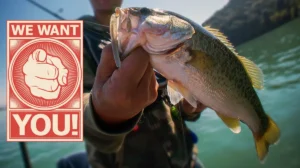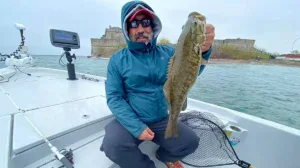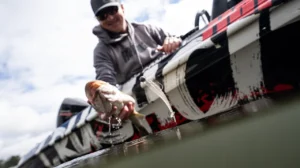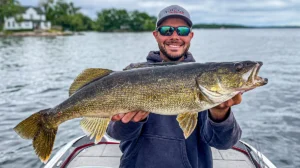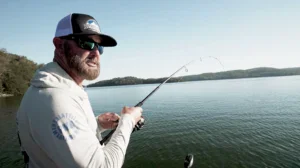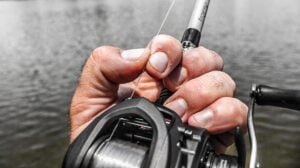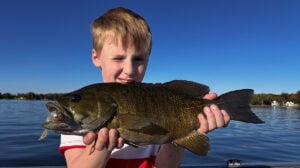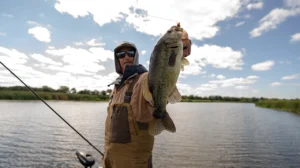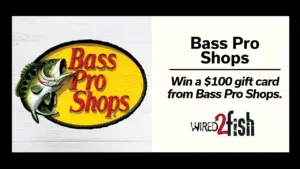Super-shallow vegetation is often overlooked and less pressured but can certainly hold big bass. When I say super shallow, we’re talking 2 feet of water or less with the trolling motor kicking up mud. Often it’s a confidence thing where many anglers just don’t believe a bass could be sitting in 6 inches of water. Other times, that depth range of the cover lies at the back of a flat and is sheltered by another 500 feet of dense vegetation like lily pads, coontail, milfoil, dollar lilies or hydrilla.
In those situations, anglers typically fish the outside edge and maybe stick the nose of their boats into the cover, but they rarely plow through to reach the far stretches. It’s not uncommon for the fish to feel that pressure and push back farther into the vegetation to seek refuge in the shallows.
When you do choose to fish this shallow, subtleness is key; both with your lure selection and boat movement. If you’re in a fiberglass or metal boat, be easy with your movements inside the boat. Don’t slam compartment lids or stomp around. Keep the trolling motor on low and ease around. But that’s when you can cast to the shallowest vegetation around without having to fight through deeper vegetation to get there.
When you do have to force your way through what equates to a knee-high flooded field, you still want to be as subtle as possible. Kayak anglers have a huge advantage here. For bigger boats, it’s best to use a push pole if you have one. But it you don’t, the only other alternative in my opinion is at the opposite end of the spectrum. You want to make however much noise you have to for as short a time as possible. So either kick the trolling motor up on high, or even plow your way in with the big motor.
While working on an article with JT Kenney several years ago, he spotted a couple mats deep in a lily pad field that he was dying to go punch. He told me to sit down and hold on as he fired up the outboard and forced his way to the mats. He killed the engine, hopped back up on the front deck and proceeded to start flipping again. He explained that those hard-to-reach mats rarely got fished and that the noise didn’t seem to bother the bass that much, as long as it was fairly short lived. He said he would often fish this way, sticking with each mat a little longer than usual to let the fish settle back down before plowing his way to the next one.
When not focusing on mats but just shallow vegetation in general, you can push pole, plow or ease your way in like this and really sit in one spot and make bomb casts in every direction for 15 to 30 minutes, never casting in the same spot twice. Your strike zone is typically small due to the vegetation around and the depth of the water. You’re not calling fish up from 15 feet deep and the vegetation makes it hard for a fish to feel or see your bait from more than 10 feet or so on either side.
As previously stated, fairly subtle baits are best. You don’t want to plop something heavy and loud right on top of their heads. You want something they can feel and see but won’t spook them. So for super-shallow vegetation, I recommend a hollow body frog, floating worm, soft-plastic stick bait with a tail spinner, toad and soft swimbait.
Now before we go any further into breaking down those baits and when, why and where you should use one over the other, there are a few honorable mentions to get out of the way. A punching setup should also come into play if there are any mats around, but for the purpose of this article we’re talking more about baits that can be used to breakdown expansive shallow vegetation. But by all means, have a punch rod rigged up to for the occasional mat you may run across.
Then there’s the swim jig, which can be fantastic at this depth range. But I like it more when there’s slightly deeper vegetation than this since it typically bogs down a bit too much this shallow. With that said, if you’re fond of a swim jig and really good with it, you can certainly use it here.
Then there are bladed jigs and lipless crankbaits, which are both phenomenal baits in shallow vegetation and even super shallow when the vegetation is really sparse, but again, we’re talking about super-shallow, denser vegetation and both of these baits tend to bog down or hang up when you start talking about fairly continuous cover in 2 feet or less.
So with that out of the way and a little better idea of the cover we’re talking about here, let’s move from discussing the baits I don’t choose and why, to the baits I do choose and why.

No. 1: Hollow body frog
This is my favorite bait for super-shallow vegetation. A hollow body frog gives you three important things you need: Something you can bomb cast, something that lands with a natural sound and it produces a really good hookup ratio.
Being able to reach the unreachable is, again, the name of the game when fishing this way. So having a virtually weedless bait you can throw a really long way is extremely important for obvious reasons. And baits like my favorite hollow body frog, the SPRO Poppin’ Frog 60, have a very natural “plop” sound when they land just like a real frog or toad would.
The third thing a hollow body frog gives you is perhaps the most important, and that is the high landing percentage. Being able to get a bait to the fish doesn’t do you any good if you can’t get the fish to you. The fish have time to target a frog, suck it all the way down and then the big, bold and powerful hooks usually latch on and don’t let go. That is absolutely necessary when dragging a 5-pounder through what feels like a 1/4 mile of mess.

No. 2: Floating worm
A floating worm seems to be a technique that falls to the wayside a lot in the mainstream fishing scene. It was a big player years ago and still comes up from time to time around the spawn, but that’s typically all you’ll hear about it. And most people either cast or skip it in open water using a spinning rod. Truth be told, a floating worm works really well in super-shallow vegetation like this as well and I personally prefer a baitcaster for it in this scenario.
My dad didn’t raise me on a spinning combo. I graduated straight from a Zebco to a baitcaster when I was about 6 because that was all there was to pick up. Dad’s always been a diehard power fishing guy and I don’t believe I ever even used a spinning rod to bass fish until I was in college. But the interesting dynamic there is that my dad loves a floating worm, one of the more finesse techniques with which you can target a bass.
So I started out throwing a floating worm on a baitcaster and still do. I like a 7-foot Fitzgerald Vursa paired with a 7.5:1 Lew’s LFS and 30-pound straight Sufix 832 Advanced braided line. My dad uses a similar setup and we basically power fish a floating worm. Once you get off into fairly thick vegetation, this setup gives you a leg up on what a spinning combo can do. The fish pay little attention to the braid amidst the strands of grass and we’ll actually mark our line with a green Sharpie as it fades over time to keep up the charade.
Fish will often give themselves away when you’re fishing this shallow. You’ll see a little wake or a fish will do a 180 under the water and a little wave will ripple out. A floating worm is probably the best bait to throw in that situation. Those fish are usually on edge, especially around the spawn and a floating worm is subtle enough to cast in the fish’s vicinity, work up to where you saw it move and be right in the fish’s face before it realizes the bait is in its world. That’s when instinct takes over and the fish typically inhales the bait.

No. 3: Stick worm with a tail spinner
Dad and I first saw Keith Poche use this bait to finish 3rd in the 2012 Bassmaster Classic on the Red River. Since then it has become a staple in our boat anytime we’re around vegetation. Basically you take a hitchhiker, a swivel and a small colorado or willow leaf blade and combine them to make an apparatus you screw up into the tail of a soft plastic stick bait like a Missile Baits The 48 Worm. What you’re left with is a super subtle presentation with a little bit of flash.
This bait is a lot like other worms you reel like a Zoom Ultravibe Speed Worm which is also great in shallow vegetation and deserves noting. Like the Speed Worm, you want a slow and steady retrieve. Sometimes we’ll let the bait get down just out of sight and sometimes we’ll wake it right along the surface. It works great anytime you’re up shallow like this, but it is the absolute perfect choice when bass are guarding fry.
The little flash at the end of the bait is the perfect size to draw the eye of a bass guarding or chasing fry. You just have to be careful when you get a bite and be sure to give the fish a second or two to get the bait all the way. A premature snatch will often result in you getting the worm and the fish getting the rest. Poche has since introduced the Humdinger Power Spinner if you want to try this out without building it yourself. Z-Man also has similar barbed product, the the TRD SpinZ Tail, that you simply push into the bait and don’t have to screw in.

No. 4: Toad
Reeling a toad like a Stanley Ribbit, Strike King Rage Toad or Zoom Horny Toad is another great way to target and especially locate fish in super-shallow vegetation. When I’m fishing like this in the summer or fall when fish are typically aggressive but may be a little more spread out, I’ll often opt for reeling a toad as opposed to throwing a hollow body frog.
You can cover a lot more water with a toad. Not only because it’s constantly on the move but also because it calls fish in from farther away. So a toad is a great search bait when fishing shallow vegetation. If you do have a fish boil on a toad or wake up on it and then drop back down, that’s when I’d pick up the floating worm and fire it back in there. If you have this happen multiple times in the same area, it’s time to pick up the hollow body frog again or go with our last bait on the list.

No. 5: Soft-plastic swimbait
The Reaction Innovations Skinny Dipper and Gambler Big EZ are two baits that work phenomenally well in super-shallow vegetation. I was first introduced to this style of fishing in the Promised Land of south Florida on Lake Okeechobee. There are few things more exciting than fishing a swimbait like this through a hayfield with a foot of water on it knowing that at any second a legit double-digit bass could try to take it away from you.
Typically with this bait I’ll either wake it just below the surface or actually buzz it along the surface like a toad. Though usually, if I’m wanting to buzz a bait along the surface I’ll just go with the toad. So I’d say 85 percent of the time I’m fishing subsurface with this bait. Which means I’m fishing it a lot like the stick bait with a tail spinner. So when do you choose which?
I like a swimbait like this when I need to make longer casts and I’m fishing around bigger fish. These swimbaits have a good bit more meat to them than a stick bait with a tail spinner, so you can throw them a good bit farther. And that allows you to beef up the hook and line size as well to try to tip the scales in your favor when colliding with larger fish.
Keeping the bait free of debris is important when fishing a swimbait like this. You typically want a nice steady retrieve so it’s best not to be snatching and popping the bait to get grass off of it if you can help it. One way to help prevent the pile up, use something like a Gambler Hollow Point. These look like bullet weight buts are made of plastic. You thread your line through the Hollow Point before tying on your hook and then you screw it into the soft plastic. This helps the bait shed vegetation and other debris better than the blunt, soft nose of most swimbaits.

In summary
There are really quite a few baits that can factor in once you start applying what you know to super-shallow vegetation. The most important thing is developing the confidence to poke your nose up there and look around. These baits are 5 that I would have on deck, but most days I’ll end up keeping one in my hand the majority of the time. Which one depends on the day.
When you’re fishing shallow like this, the curtain is much thinner between you and the fish. You’re able to interact with them more and judge what you need to do based on their behavior. Pay close attention to what’s going on around you. Look for little ripples on the surface or muddy spots where a fish took off.
Keep your eyes peeled for wakes headed in your bait’s direction. Often times, those fish won’t commit until you vary the retrieve. Or at times, they won’t do anything on that initial interaction and you’ll have to reignite the debate with a follow-up bait.
But if you’re not paying attention, you won’t see that wake and never know the fish was there. You won’t see fry scatter as the shadow of a passing bird crosses their path. You’ll miss that ripple on the water. You won’t see the blade of grass jump. You won’t notice that mud spot and modify your movements so as to not spook the fish.
The most important thing is knowing the fish is there before the fish knows you’re there. So everything up shallow needs to be as subtle as possible. And make sure the gear you tie these baits onto is up for the task-strong reels, strong rods, strong hooks and braided line. On that note, I’ll leave you with some sage wisdom that I learned at an early age.
“You should never go bear hunting with a switch.”


